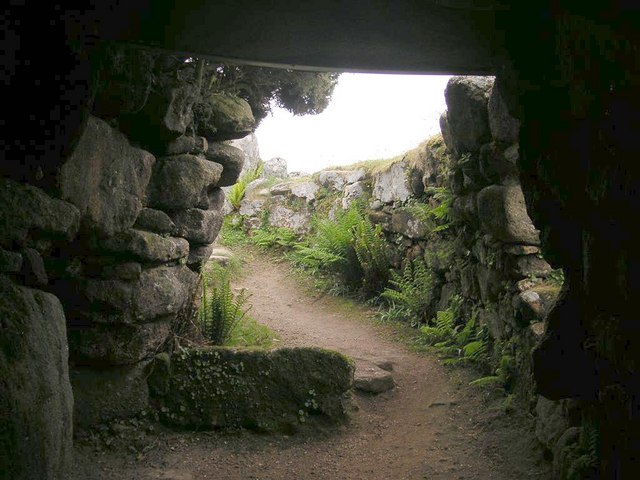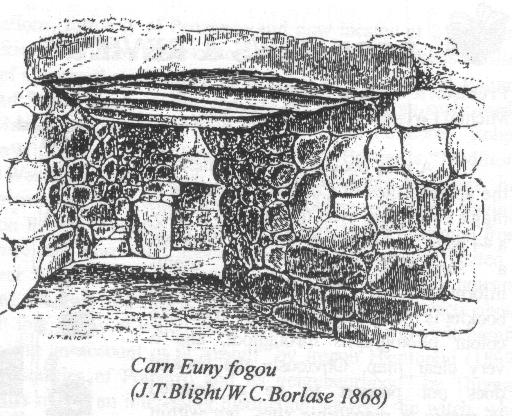Carn Euny on:
[Wikipedia]
[Google]
[Amazon]
Carn Euny (from )Place-names in the Standard Written Form (SWF)
List of place-names agreed by the MAGA Signage Panel
. Cornish Language Partnership. is an archaeological site near Sancreed, on the
 Carn Euny lies in southwest
Carn Euny lies in southwest
 The site was discovered in the early 19th Century by prospectors searching for tin deposits. Between 1863 and 1868, the antiquarian
The site was discovered in the early 19th Century by prospectors searching for tin deposits. Between 1863 and 1868, the antiquarian
 West of the settlement are a pair of ancient wells. One is mentioned in ''The Legendary Lore of the Holy Wells of England'' of 1893 where William Borlase states (writing in the 1750s):
West of the settlement are a pair of ancient wells. One is mentioned in ''The Legendary Lore of the Holy Wells of England'' of 1893 where William Borlase states (writing in the 1750s):
History on Carn Euny: English HeritageDigital tour of the Carn Euny fogou
* {{Coord, 50.10234, N, 5.63448, W, region:GB_source:enwiki-osgb36(SW402288), display=title Buildings and structures in Cornwall History of Cornwall Iron Age sites in Cornwall Prehistoric sites in Cornwall English Heritage sites in Cornwall Cornish courtyard houses Fogous
List of place-names agreed by the MAGA Signage Panel
. Cornish Language Partnership. is an archaeological site near Sancreed, on the
Penwith
Penwith (; ) is an area of Cornwall, England, located on the peninsula of the same name. It is also the name of a former Non-metropolitan district, local government district, whose council was based in Penzance. The area is named after one ...
peninsula in Cornwall
Cornwall (; or ) is a Ceremonial counties of England, ceremonial county in South West England. It is also one of the Celtic nations and the homeland of the Cornish people. The county is bordered by the Atlantic Ocean to the north and west, ...
, United Kingdom. It consists of evidence of both Iron Age
The Iron Age () is the final epoch of the three historical Metal Ages, after the Chalcolithic and Bronze Age. It has also been considered as the final age of the three-age division starting with prehistory (before recorded history) and progre ...
and post-Iron Age settlement, with excavation on the site showning activity at Carn Euny as early as the Neolithic period. The first timber huts there were built about 500 BC, and 400-500 years later were replaced by stone huts; the remains of which are still visible.
Carn Euny is best known for the well-preserved state of the large fogou
A fogou or fougou (pronounced "foo-goo") is an underground, dry-stone structure found on Iron Age or Romano-British-defended settlement sites in Cornwall. The original purpose of a fogou is uncertain today. Colloquially called , , , giant holts ...
, an underground passageway, which is more than long. This fogou runs just below the surface of the ground and is roofed with massive stone slabs.
The site was abandoned late in the Roman
Roman or Romans most often refers to:
*Rome, the capital city of Italy
*Ancient Rome, Roman civilization from 8th century BC to 5th century AD
*Roman people, the people of Roman civilization
*Epistle to the Romans, shortened to Romans, a letter w ...
period.
Location
 Carn Euny lies in southwest
Carn Euny lies in southwest Cornwall
Cornwall (; or ) is a Ceremonial counties of England, ceremonial county in South West England. It is also one of the Celtic nations and the homeland of the Cornish people. The county is bordered by the Atlantic Ocean to the north and west, ...
in the Penwith
Penwith (; ) is an area of Cornwall, England, located on the peninsula of the same name. It is also the name of a former Non-metropolitan district, local government district, whose council was based in Penzance. The area is named after one ...
District, near the village of Sancreed. The archaeological site can be accessed at any time and the admission is free. Parking can be found in the nearby hamlet of Brane
In string theory and related theories (such as supergravity), a brane is a physical object that generalizes the notion of a zero-dimensional point particle, a one-dimensional string, or a two-dimensional membrane to higher-dimensional objec ...
. The site is overlooked by the Iron Age hill fort
A hillfort is a type of fortification, fortified refuge or defended settlement located to exploit a rise in elevation for defensive advantage. They are typical of the late Bronze Age Europe, European Bronze Age and Iron Age Europe, Iron Age. So ...
of Caer Bran. Another similar Romano-British settlement is Chysauster about 10 km to the northeast. Carn Euny is managed by the Cornwall Heritage Trust.
Construction
Traces of human activity in Carn Euny have been detected from the earlyNeolithic
The Neolithic or New Stone Age (from Ancient Greek, Greek 'new' and 'stone') is an archaeological period, the final division of the Stone Age in Mesopotamia, Asia, Europe and Africa (c. 10,000 BCE to c. 2,000 BCE). It saw the Neolithic Revo ...
period. Iron Age round houses of wattle and daub
Wattle and daub is a composite material, composite building method in which a woven lattice of wooden strips called "wattle (construction), wattle" is "daubed" with a sticky material usually made of some combination of wet soil, clay, sand, and ...
, mud and wood were built around 500-400 BC, and replaced by stone houses starting in the 1st century BC. Some of these stone houses were "replaced with larger, stone ‘courtyard’ houses" between 200-400 AD, the remains of which are the ruins still visible above ground as the older roundhouses are only left as sub-surface ruins. Seven single-room stone houses, of both a round and oval form, and three courtyard houses are in evidence; courtyard houses only being found in Cornwall.
The most important structure of the site is the fogou
A fogou or fougou (pronounced "foo-goo") is an underground, dry-stone structure found on Iron Age or Romano-British-defended settlement sites in Cornwall. The original purpose of a fogou is uncertain today. Colloquially called , , , giant holts ...
(''Ogo'' being Cornish for cave), a man-made underground passage which is covered with massive stone slabs. Fogous can be found in other places in the UK and Ireland, and are known more generally as souterrain
''Souterrain'' (from French ', meaning "subterrain", is a name given by archaeologists to a type of underground structure associated mainly with the European Atlantic Iron Age.
These structures appear to have been brought northwards from Gaul d ...
s. Their purpose is unclear. The fogou at Carn Euny is in particularly good condition and consists of a 20 m long corridor, with a side passage that leads to a round stone chamber with a collapsed roof, and a small tunnel which may be a second entrance.
At this time the people of Carn Euny lived from agriculture, livestock, trade, and perhaps tin mining
Tin mining began early in the Bronze Age, as bronze is a copper-tin alloy. Tin is a relatively rare element in the Earth's crust, with approximately 2 ppm (parts per million), compared to iron with 50,000 ppm.
History
Tin extraction and use ca ...
. Evidence of farming here includes 40 acres enclosed within a field boundary, which is most likely the area farmed by this settlement. The inhabitants likely grew oats, barley and rye, and kept sheep, goat
The goat or domestic goat (''Capra hircus'') is a species of Caprinae, goat-antelope that is mostly kept as livestock. It was domesticated from the wild goat (''C. aegagrus'') of Southwest Asia and Eastern Europe. The goat is a member of the ...
s and cattle. The courtyard houses "may have been used for stabling livestock, crop processing and outdoor cooking."
Excavations
 The site was discovered in the early 19th Century by prospectors searching for tin deposits. Between 1863 and 1868, the antiquarian
The site was discovered in the early 19th Century by prospectors searching for tin deposits. Between 1863 and 1868, the antiquarian William Copeland Borlase
William Copeland Borlase (5 April 1848 – 31 March 1899) was a British antiquarian and Liberal politician who sat in the House of Commons from 1880 until 1887 when he was ruined by bankruptcy and scandal.
Early life
Borlase was born at Cas ...
examined the archaeological site and exposed the fogou. The graphic artist John Thomas Blight made corresponding engravings for the excavation report. During the 1920s, Dr. Favell and Canon Taylor discovered the foundation walls of the houses with courtyards. Between 1964 and 1972, extensive excavations were carried out, in which nine hut foundations were discovered. The fogou and the circular chamber were investigated and restored. Four main occupation phases between the 5th century BC and the 4th century AD were found.
Chapel Euny Well
 West of the settlement are a pair of ancient wells. One is mentioned in ''The Legendary Lore of the Holy Wells of England'' of 1893 where William Borlase states (writing in the 1750s):
West of the settlement are a pair of ancient wells. One is mentioned in ''The Legendary Lore of the Holy Wells of England'' of 1893 where William Borlase states (writing in the 1750s):''"I happened luckily to be at this well upon the last day of the year, on which, according to vulgar opinion, it exerts its principal and most salutary powers. Two women were here, who came from a neighbouring parish, and were busily employed in bathing a child. They both assured me that people who had a mind to receive any benefit from St. Euny's Well must come and wash upon the three first Wednesdays in May. Children suffering from mesenteric disease''Mesenteric disease'' is tuberculosis of lymph glands inside the abdomen. An illness of children caused by drinking milk from cows infected with tuberculosis. Now uncommon as milk is pasteurised should be dipped three times in Chapel Uny widderschynnes, and widderschynnes dragged three times round the well."''It is also referred to as St. Eurinus' or Uny's Well (i.e. well of St Euny) and may be confused with Saint Euny's Well at Carn Brea.
See also
* Chysauster *Petrosomatoglyph
A petrosomatoglyph is a supposed image of parts of a human or animal body in rock. They occur all over the world, often functioning as an important form of symbolism, used in religious and secular ceremonies, such as the crowning of kings. Some ...
Symbolism
*Ringfort
Ringforts or ring forts are small circular fortification, fortified settlements built during the Bronze Age, Iron Age and early Middle Ages up to about the year 1000 AD. They are found in Northern Europe, especially in Ireland. There are ...
References
External links
History on Carn Euny: English Heritage
* {{Coord, 50.10234, N, 5.63448, W, region:GB_source:enwiki-osgb36(SW402288), display=title Buildings and structures in Cornwall History of Cornwall Iron Age sites in Cornwall Prehistoric sites in Cornwall English Heritage sites in Cornwall Cornish courtyard houses Fogous